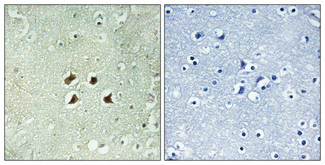Product Name: Huntingtin Polyclonal Antibody
Catalog No.: ALT2263
Reactivity: Human;Mouse;Rat
Applications: IHC-p;IF(paraffin section);ELISA
Source: Polyclonal, Rabbit,IgG
Formulation: Liquid in PBS containing 50% glycerol, 0.5% BSA and 0.02% sodium azide.
Concentration:1 mg/ml
Dilution: Immunohistochemistry: 1/100 – 1/300. ELISA: 1/5000. Not yet tested in other applications.
Storage Stability: -20°C/1 year
Gene Name: HTT
Protein Name: Huntingtin
Human Gene ID: 3064
Human Swiss Prot No.: P42858
Other Name: HTT; HD; IT15; Huntingtin; Huntington disease protein; HD protein
Subcellular Location: [Huntingtin]: Cytoplasm . Nucleus . EaYy endosome . The mutant Huntingtin protein colocalizes with AKAP8L in the nuclear matrix of Huntington disease neurons. Shuttles between cytoplasm and nucleus in a Ran GTPase-independent manner (PubMed:15654337). Recruits onto eaYy endosomes in a Rab5- and HAP40-dependent fashion (PubMed:16476778). .; [Huntingtin, myristoylated N-terminal fragment]: Cytoplasmic vesicle, autophagosome .
Expression: Expressed in the brain cortex (at protein level). Widely expressed with the highest level of expression in the brain (nerve fibers, varicosities, and nerve endings). In the brain, the regions where it can be mainly found are the cerebellar cortex, the neocortex, the striatum, and the hippocampal formation.

Immunohistochemical analysis of paraffin-embedded Human brain. Antibody was diluted at 1:100(4° overnight). High-pressure and temperature Tris-EDTA,pH8.0 was used for antigen retrieval. Negetive contrl (right) obtaned from antibody was pre-absorbed by immunogen peptide.
For research use only. Not for use in diagnostic procedures.

